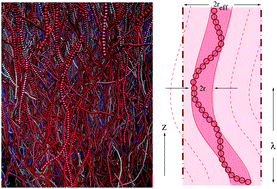A new insight into the isotropic–nematic phase transition in lyotropic solutions of semiflexible polymers: density-functional theory tested by molecular dynamics
Abstract
Semiflexible polymers in solution are studied for a wide range of both contour length L and persistence length  p as a function of monomer concentration under good solvent conditions. Both density-functional theory (DFT) and molecular dynamics (MD) simulation methods are used, and a very good agreement between both techniques is observed for rather stiff polymers. Evidence for a new mechanism of order parameter fluctuations in the nematic phase is presented, namely collective deformations of bundles of wormlike chains twisted around each other, and the typical wavelengths and amplitudes of these modes are estimated. These long wavelength fluctuations cause a reduction of the order parameter in comparison with the DFT prediction. It is also found that DFT becomes unreliable for rather flexible polymers in predicting that the transition from the isotropic (I)-phase to the nematic (N)-phase still exists at very high monomer concentrations (which in reality does not occur). However, under conditions when DFT is accurate, it provides reliable predictions also for the width of the I–N two-phase coexistence region, which are difficult to obtain from MD in spite of the use of very large systems (up to 500 000 monomers) by means of graphics processing units (GPU). For short and not very stiff chains, a pre-transitional chain stretching is found in the isotropic phase near the I–N-transition, not predicted by theories. A comparison with theoretical predictions by Khokhlov–Semenov, Odijk, and Chen reveals that the scaled transition densities are not simply functions of L/
p as a function of monomer concentration under good solvent conditions. Both density-functional theory (DFT) and molecular dynamics (MD) simulation methods are used, and a very good agreement between both techniques is observed for rather stiff polymers. Evidence for a new mechanism of order parameter fluctuations in the nematic phase is presented, namely collective deformations of bundles of wormlike chains twisted around each other, and the typical wavelengths and amplitudes of these modes are estimated. These long wavelength fluctuations cause a reduction of the order parameter in comparison with the DFT prediction. It is also found that DFT becomes unreliable for rather flexible polymers in predicting that the transition from the isotropic (I)-phase to the nematic (N)-phase still exists at very high monomer concentrations (which in reality does not occur). However, under conditions when DFT is accurate, it provides reliable predictions also for the width of the I–N two-phase coexistence region, which are difficult to obtain from MD in spite of the use of very large systems (up to 500 000 monomers) by means of graphics processing units (GPU). For short and not very stiff chains, a pre-transitional chain stretching is found in the isotropic phase near the I–N-transition, not predicted by theories. A comparison with theoretical predictions by Khokhlov–Semenov, Odijk, and Chen reveals that the scaled transition densities are not simply functions of L/ p only, as these theories predict, but depend on d/
p only, as these theories predict, but depend on d/ p (where d is the chain diameter) as well. Chain properties in the nematically ordered phase are compared to those of chains confined in tubes, and the deflection length concept is tested. Eventually, some consequences for the interpretation of experiments are spelled out.
p (where d is the chain diameter) as well. Chain properties in the nematically ordered phase are compared to those of chains confined in tubes, and the deflection length concept is tested. Eventually, some consequences for the interpretation of experiments are spelled out.


 Please wait while we load your content...
Please wait while we load your content...